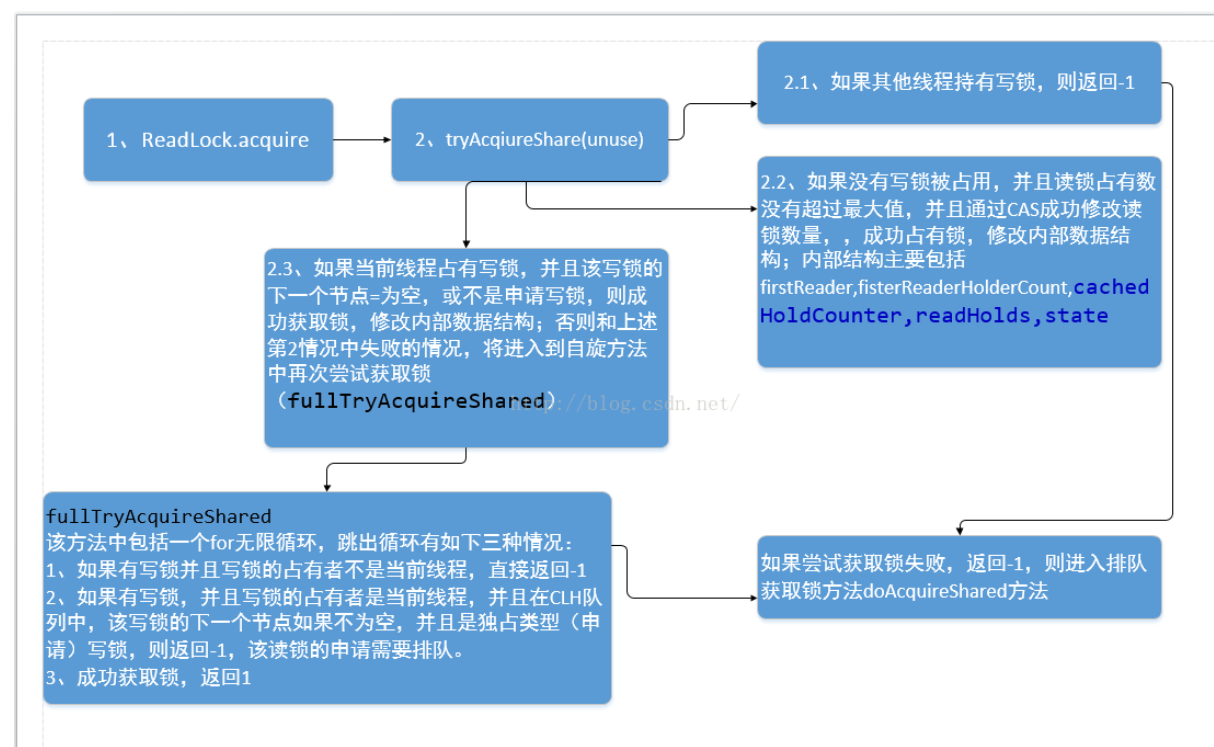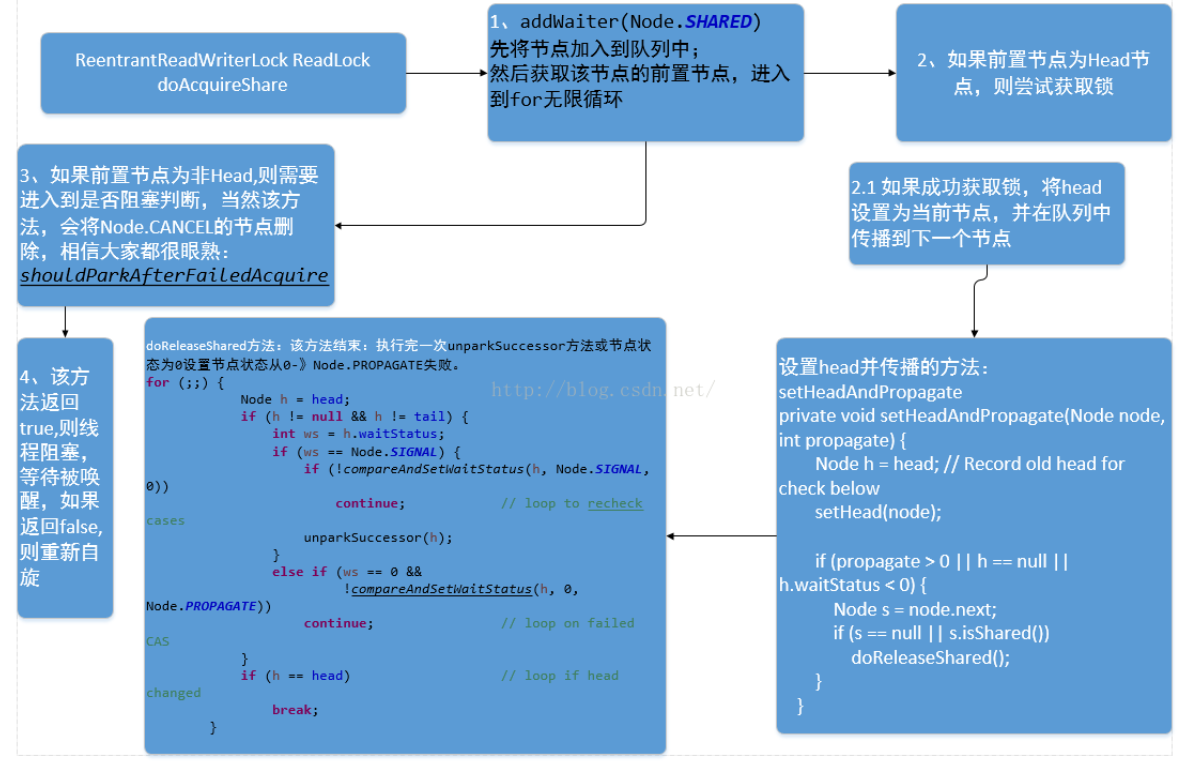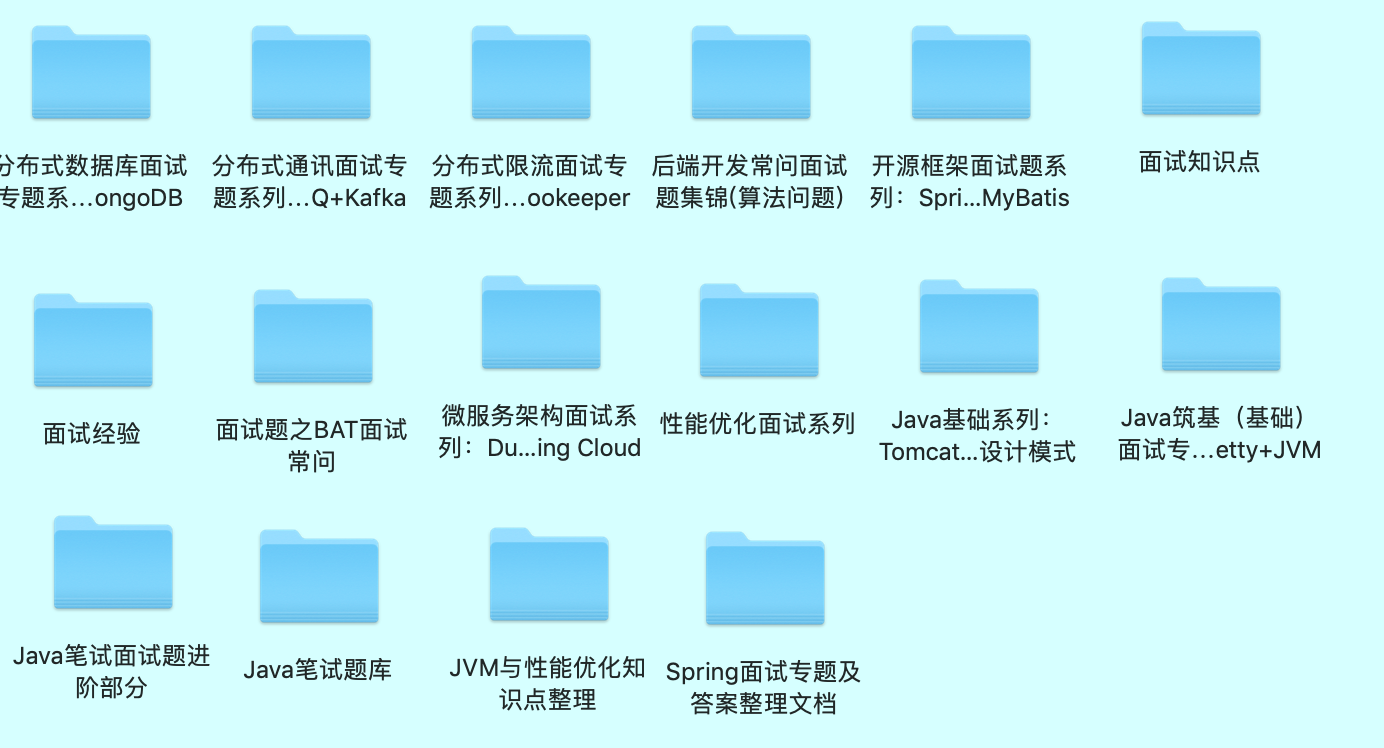java并发锁ReentrantReadWriteLock读写锁源码分析
public interface ReadWriteLock {
/**
* Returns the lock used for reading.
*
* @return the lock used for reading.
*/
Lock readLock();
/**
* Returns the lock used for writing.
*
* @return the lock used for writing.
*/
Lock writeLock();
}
/*
* Read vs write count extraction constants and functions.
* Lock state is logically divided into two unsigned shorts:
* The lower one representing the exclusive (writer) lock hold count,
* and the upper the shared (reader) hold count.
*/
static final int SHARED_SHIFT = 16;
static final int SHARED_UNIT = (1 << SHARED_SHIFT);
static final int MAX_COUNT = (1 << SHARED_SHIFT) - 1;
static final int EXCLUSIVE_MASK = (1 << SHARED_SHIFT) - 1;
/** Returns the number of shared holds represented in count */
static int sharedCount(int c) { return c >>> SHARED_SHIFT; }
/** Returns the number of exclusive holds represented in count */
static int exclusiveCount(int c) { return c & EXCLUSIVE_MASK; }
SHARED_SHIFT,表示读锁占用的位数,常量16
SHARED_UNIT, 增加一个读锁,按照上述设计,就相当于增加 SHARED_UNIT;
MAX_COUNT ,表示申请读锁最大的线程数量,为65535
EXCLUSIVE_MASK :表示计算写锁的具体值时,该值为 15个1,用 getState & EXCLUSIVE_MASK算出写锁的线程数,大于1表示重入。
static int sharedCount(int c) { return c >>> SHARED_SHIFT; }
static int exclusiveCount(int c) { return c & EXCLUSIVE_MASK; }
/**
* The number of reentrant read locks held by current thread.
* Initialized only in constructor and readObject.
* Removed whenever a thread's read hold count drops to 0.
*/
private transient ThreadLocalHoldCounter readHolds;
/**
* The hold count of the last thread to successfully acquire
* readLock. This saves ThreadLocal lookup in the common case
* where the next thread to release is the last one to
* acquire. This is non-volatile since it is just used
* as a heuristic, and would be great for threads to cache.
*
* <p>Can outlive the Thread for which it is caching the read
* hold count, but avoids garbage retention by not retaining a
* reference to the Thread.
*
* <p>Accessed via a benign data race; relies on the memory
* model's final field and out-of-thin-air guarantees.
*/
private transient HoldCounter cachedHoldCounter;
/**
* firstReader is the first thread to have acquired the read lock.
* firstReaderHoldCount is firstReader's hold count.
*
* <p>More precisely, firstReader is the unique thread that last
* changed the shared count from 0 to 1, and has not released the
* read lock since then; null if there is no such thread.
*
* <p>Cannot cause garbage retention unless the thread terminated
* without relinquishing its read locks, since tryReleaseShared
* sets it to null.
*
* <p>Accessed via a benign data race; relies on the memory
* model's out-of-thin-air guarantees for references.
*
* <p>This allows tracking of read holds for uncontended read
* locks to be very cheap.
*/
private transient Thread firstReader = null;
private transient int firstReaderHoldCount;
上述这4个变量,其实就是完成一件事情,将获取读锁的线程放入线程本地变量(ThreadLocal),方便从整个上 下文,根据当前线程获取持有锁的次数信息。其实 firstReader,firstReaderHoldCount ,cachedHoldCounter 这三个变量就是为readHolds变量服务的,是一个优化手段,尽量减少直接使用readHolds.get方法的次数,firstReader与firstReadHoldCount保存第一个获取读锁的线程,也就是readHolds中并不会保存第一个获取读锁的线程;cachedHoldCounter 缓存的是最后一个获取线程的HolderCount信息,该变量主要是在如果当前线程多次获取读锁时,减少从readHolds中获取HoldCounter的次数。请结合如下代码理解上述观点:
if (r == 0) {
firstReader = current;
firstReaderHoldCount = 1;
} else if (firstReader == current) {
firstReaderHoldCount++;
} else {
HoldCounter rh = cachedHoldCounter;
if (rh == null || rh.tid != current.getId())
cachedHoldCounter = rh = readHolds.get();
else if (rh.count == 0)
readHolds.set(rh);
rh.count++;
}
2、ReentrantReadWriterLock源码分析
大家可以点击加群【JAVA架构知识学习讨论群】473984645,(如多你想跳槽换工作,但是技术又不够,或者工作遇到了瓶颈,我这里有一个Java的免费直播课程,讲的是高端的知识点,只要有1-5年的开发工作经验可以加群找我要课堂链接。)注意:是免费的 没有开发经验的误入。
2.1 ReadLock 源码分析
2.1.1 lock方法
/**
* Acquires the read lock.
*
* <p>Acquires the read lock if the write lock is not held by
* another thread and returns immediately.
*
* <p>If the write lock is held by another thread then
* the current thread becomes disabled for thread scheduling
* purposes and lies dormant until the read lock has been acquired.
*/
public void lock() {
sync.acquireShared(1);
}
sync.acquireShared方法存在于AbstractQueuedSynchronizer类中,
/**
* Acquires in shared mode, ignoring interrupts. Implemented by
* first invoking at least once {@link #tryAcquireShared},
* returning on success. Otherwise the thread is queued, possibly
* repeatedly blocking and unblocking, invoking {@link
* #tryAcquireShared} until success.
*
* @param arg the acquire argument. This value is conveyed to
* {@link #tryAcquireShared} but is otherwise uninterpreted
* and can represent anything you like.
*/
public final void acquireShared(int arg) {
if (tryAcquireShared(arg) < 0) //@1
doAcquireShared(arg); //@2
}
根据常识,具体获取锁的过程在子类中实现,果不其然,tryAcquireShared方法在ReentrantReadWriterLock的Sync类中实现
protected final int tryAcquireShared(int unused) {
/*
* Walkthrough:
* 1. If write lock held by another thread, fail.
* 2. Otherwise, this thread is eligible for
* lock wrt state, so ask if it should block
* because of queue policy. If not, try
* to grant by CASing state and updating count.
* Note that step does not check for reentrant
* acquires, which is postponed to full version
* to avoid having to check hold count in
* the more typical non-reentrant case.
* 3. If step 2 fails either because thread
* apparently not eligible or CAS fails or count
* saturated, chain to version with full retry loop.
*/
Thread current = Thread.currentThread(); //@1 start
int c = getState();
if (exclusiveCount(c) != 0 &&
getExclusiveOwnerThread() != current)
return -1; // @1 end
int r = sharedCount(c);
if (!readerShouldBlock() &&
r < MAX_COUNT &&
compareAndSetState(c, c + SHARED_UNIT)) { // @2
if (r == 0) { //@21
firstReader = current;
firstReaderHoldCount = 1;
} else if (firstReader == current) { //@22
firstReaderHoldCount++;
} else { // @23
HoldCounter rh = cachedHoldCounter;
if (rh == null || rh.tid != current.getId())
cachedHoldCounter = rh = readHolds.get();
else if (rh.count == 0)
readHolds.set(rh);
rh.count++;
}
return 1;
}
return fullTryAcquireShared(current); // @3
}
final boolean readerShouldBlock() {
/* As a heuristic to avoid indefinite writer starvation,
* block if the thread that momentarily appears to be head
* of queue, if one exists, is a waiting writer. This is
* only a probabilistic effect since a new reader will not
* block if there is a waiting writer behind other enabled
* readers that have not yet drained from the queue.
*/
return apparentlyFirstQueuedIsExclusive(); //该方法,具体又是在 AbstractQueuedSynchronizer中
}
/**
* Returns {@code true} if the apparent first queued thread, if one
* exists, is waiting in exclusive mode. If this method returns
* {@code true}, and the current thread is attempting to acquire in
* shared mode (that is, this method is invoked from {@link
* #tryAcquireShared}) then it is guaranteed that the current thread
* is not the first queued thread. Used only as a heuristic in
* ReentrantReadWriteLock.
*/
final boolean apparentlyFirstQueuedIsExclusive() {
Node h, s;
return (h = head) != null &&
(s = h.next) != null &&
!s.isShared() &&
s.thread != null;
}
当前线程占有写锁,并且没有有其他写锁在当前线程的下一个节点等待获取写锁。;其实如果是这种情况,除非当前线程占有锁的下个线程取消,否则进入fullTryAcquireShared方法也无法获取锁。
/**
* Full version of acquire for reads, that handles CAS misses
* and reentrant reads not dealt with in tryAcquireShared.
*/
final int fullTryAcquireShared(Thread current) {
/*
* This code is in part redundant with that in
* tryAcquireShared but is simpler overall by not
* complicating tryAcquireShared with interactions between
* retries and lazily reading hold counts.
*/
HoldCounter rh = null;
for (;;) {
int c = getState();
if (exclusiveCount(c) != 0) { //@31
if (getExclusiveOwnerThread() != current)
return -1;
// else we hold the exclusive lock; blocking here
// would cause deadlock.
} else if (readerShouldBlock()) { //@32
// Make sure we're not acquiring read lock reentrantly
if (firstReader == current) { //@33
// assert firstReaderHoldCount > 0;
} else { //@34
if (rh == null) {
rh = cachedHoldCounter;
if (rh == null || rh.tid != current.getId()) {
rh = readHolds.get();
if (rh.count == 0)
readHolds.remove();
}
}
if (rh.count == 0)
return -1;
}
}
if (sharedCount(c) == MAX_COUNT)
throw new Error("Maximum lock count exceeded");
if (compareAndSetState(c, c + SHARED_UNIT)) { // @35
if (sharedCount(c) == 0) {
firstReader = current;
firstReaderHoldCount = 1;
} else if (firstReader == current) {
firstReaderHoldCount++;
} else {
if (rh == null)
rh = cachedHoldCounter;
if (rh == null || rh.tid != current.getId())
rh = readHolds.get();
else if (rh.count == 0)
readHolds.set(rh);
rh.count++;
cachedHoldCounter = rh; // cache for release
}
return 1;
}
}
}
public final void acquireShared(int arg) {
if (tryAcquireShared(arg) < 0) //@1
doAcquireShared(arg); //@2
}
/**
* Acquires in shared uninterruptible mode.
* @param arg the acquire argument
*/
private void doAcquireShared(int arg) {
final Node node = addWaiter(Node.SHARED); //@1
boolean failed = true;
try {
boolean interrupted = false;
for (;;) { // @2,开始自旋重试
final Node p = node.predecessor(); // @3
if (p == head) { // @4
int r = tryAcquireShared(arg);
if (r >= 0) {
setHeadAndPropagate(node, r); //@5
p.next = null; // help GC
if (interrupted)
selfInterrupt();
failed = false;
return;
}
}
if (shouldParkAfterFailedAcquire(p, node) &&
parkAndCheckInterrupt()) // @6
interrupted = true;
}
} finally {
if (failed)
cancelAcquire(node);
}
}
/**
* Sets head of queue, and checks if successor may be waiting
* in shared mode, if so propagating if either propagate > 0 or
* PROPAGATE status was set.
*
* @param node the node
* @param propagate the return value from a tryAcquireShared
*/
private void setHeadAndPropagate(Node node, int propagate) {
Node h = head; // Record old head for check below
setHead(node);
/*
* Try to signal next queued node if:
* Propagation was indicated by caller,
* or was recorded (as h.waitStatus) by a previous operation
* (note: this uses sign-check of waitStatus because
* PROPAGATE status may transition to SIGNAL.)
* and
* The next node is waiting in shared mode,
* or we don't know, because it appears null
*
* The conservatism in both of these checks may cause
* unnecessary wake-ups, but only when there are multiple
* racing acquires/releases, so most need signals now or soon
* anyway.
*/
if (propagate > 0 || h == null || h.waitStatus < 0) { // @1
Node s = node.next;
if (s == null || s.isShared()) // @2
doReleaseShared(); //@3
}
}
/**
* Sets head of queue to be node, thus dequeuing. Called only by
* acquire methods. Also nulls out unused fields for sake of GC
* and to suppress unnecessary signals and traversals.
*
* @param node the node
*/
private void setHead(Node node) {
head = node;
node.thread = null;
node.prev = null;
}
/**
* Release action for shared mode -- signal successor and ensure
* propagation. (Note: For exclusive mode, release just amounts
* to calling unparkSuccessor of head if it needs signal.)
*/
private void doReleaseShared() {
/*
* Ensure that a release propagates, even if there are other
* in-progress acquires/releases. This proceeds in the usual
* way of trying to unparkSuccessor of head if it needs
* signal. But if it does not, status is set to PROPAGATE to
* ensure that upon release, propagation continues.
* Additionally, we must loop in case a new node is added
* while we are doing this. Also, unlike other uses of
* unparkSuccessor, we need to know if CAS to reset status
* fails, if so rechecking.
*/
for (;;) {
Node h = head;
if (h != null && h != tail) { //@4
int ws = h.waitStatus;
if (ws == Node.SIGNAL) { //@5
if (!compareAndSetWaitStatus(h, Node.SIGNAL, 0))
continue; // loop to recheck cases
unparkSuccessor(h);
}
else if (ws == 0 &&
!compareAndSetWaitStatus(h, 0, Node.PROPAGATE)) //@6
continue; // loop on failed CAS
}
if (h == head) // loop if head changed //@7
break;
}
}

尝试获取读锁过程
从队列中获取读锁的流程如下:

2.1.2 ReadLock 的 unlock方法详解
public void unlock() {
sync.releaseShared(1);
}
//AbstractQueuedSynchronizer的 realseShared方法
public final boolean releaseShared(int arg) {
if (tryReleaseShared(arg)) {
doReleaseShared();
return true;
}
return false;
}
// ReentrantReadWriterLock.Sync tryReleaseShared
protected final boolean tryReleaseShared(int unused) {
Thread current = Thread.currentThread();
if (firstReader == current) { // @1 start
// assert firstReaderHoldCount > 0;
if (firstReaderHoldCount == 1)
firstReader = null;
else
firstReaderHoldCount--;
} else {
HoldCounter rh = cachedHoldCounter;
if (rh == null || rh.tid != current.getId())
rh = readHolds.get();
int count = rh.count;
if (count <= 1) {
readHolds.remove();
if (count <= 0)
throw unmatchedUnlockException();
}
--rh.count; // @1 end
}
for (;;) { // @2
int c = getState();
int nextc = c - SHARED_UNIT;
if (compareAndSetState(c, nextc))
// Releasing the read lock has no effect on readers,
// but it may allow waiting writers to proceed if
// both read and write locks are now free.
return nextc == 0;
}
}
AbstractQueuedSynchronizer的doReleaseShared
/**
* Release action for shared mode -- signal successor and ensure
* propagation. (Note: For exclusive mode, release just amounts
* to calling unparkSuccessor of head if it needs signal.)
*/
private void doReleaseShared() {
/*
* Ensure that a release propagates, even if there are other
* in-progress acquires/releases. This proceeds in the usual
* way of trying to unparkSuccessor of head if it needs
* signal. But if it does not, status is set to PROPAGATE to
* ensure that upon release, propagation continues.
* Additionally, we must loop in case a new node is added
* while we are doing this. Also, unlike other uses of
* unparkSuccessor, we need to know if CAS to reset status
* fails, if so rechecking.
*/
for (;;) {
Node h = head;
if (h != null && h != tail) {
int ws = h.waitStatus;
if (ws == Node.SIGNAL) {
if (!compareAndSetWaitStatus(h, Node.SIGNAL, 0))
continue; // loop to recheck cases
unparkSuccessor(h);
}
else if (ws == 0 &&
!compareAndSetWaitStatus(h, 0, Node.PROPAGATE))
continue; // loop on failed CAS
}
if (h == head) // loop if head changed
break;
}
}
public void lock() {
sync.acquire(1);
}
public final void acquire(int arg) {
if (!tryAcquire(arg) &&
acquireQueued(addWaiter(Node.EXCLUSIVE), arg))
selfInterrupt();
}
对上述代码是不是似曾相识,对了,在学习ReentrantLock时候,看到的一样,acquire是在AbstractQueuedSynchronizer中,关键是在 tryAcquire方法,是在不同的子类中实现的。那我们将目光移到ReentrantReadWriterLock.Sync中
protected final boolean tryAcquire(int acquires) {
/*
* Walkthrough:
* 1. If read count nonzero or write count nonzero
* and owner is a different thread, fail.
* 2. If count would saturate, fail. (This can only
* happen if count is already nonzero.)
* 3. Otherwise, this thread is eligible for lock if
* it is either a reentrant acquire or
* queue policy allows it. If so, update state
* and set owner.
*/
Thread current = Thread.currentThread();
int c = getState();
int w = exclusiveCount(c);
if (c != 0) { // @1
// (Note: if c != 0 and w == 0 then shared count != 0)
if (w == 0 || current != getExclusiveOwnerThread()) //@2
return false;
if (w + exclusiveCount(acquires) > MAX_COUNT)
throw new Error("Maximum lock count exceeded");
// Reentrant acquire
setState(c + acquires); //@3
return true;
}
if (writerShouldBlock() ||
!compareAndSetState(c, c + acquires)) //@4
return false;
setExclusiveOwnerThread(current); //@5
return true;
}


最新文章
- HTTP协议系列(1)
- Lind.DDD.LindMQ的一些想法
- Java并发编程核心方法与框架-TheadPoolExecutor的使用
- Android 的EditText实现不可编辑
- 根据之前的博文,我把给同学做的三子棋小游戏的代码发出来,只是界面很丑很丑,AI算法很笨很笨,过几天我传到网盘上,提供大家下载娱乐
- VC++6.0环境下调试c语言代码的方法和步骤_附图
- 编码问题 关于hibernate jdbc数据库连接在xml配置与在properties文件配置的差异
- Java集合类操作优化总结
- Python中sys.argv[]的用法
- HDU 5012 Dice DFS
- Java基础学习笔记七 Java基础语法之继承和抽象类
- HashMap 你真的了解吗?
- [bzoj4922]Karp-de-Chant Number
- java 接口1
- OsWatcher 使用详解
- setuid setgid
- 初识CPU卡、SAM卡/CPU卡简介、SAM卡简介 【转】
- Codeforces Round #404 (Div. 2) C. Anton and Fairy Tale 二分
- easyui------修改validatebox过滤规则
- Python tricks(1) -- 动态定义一个新变量